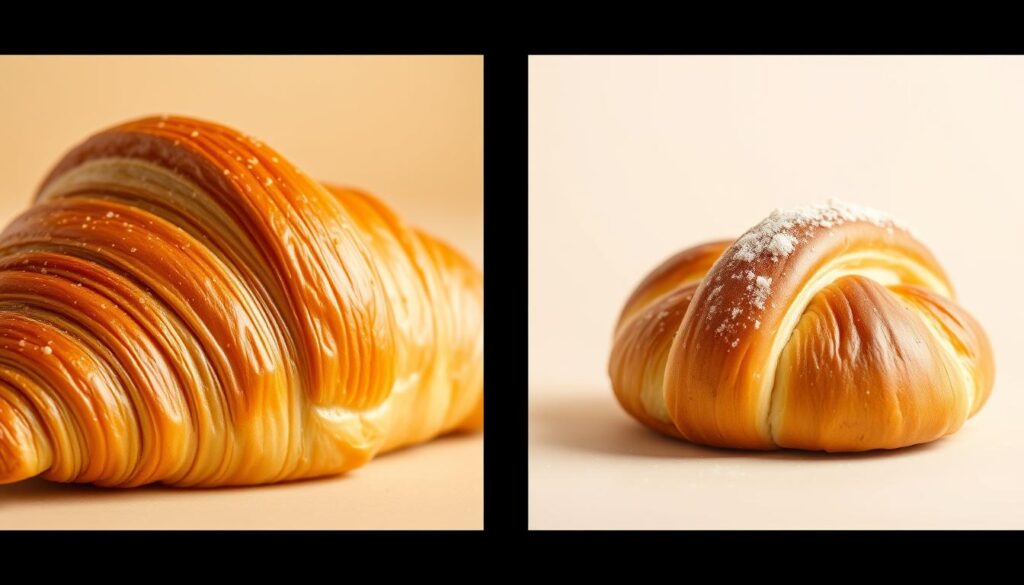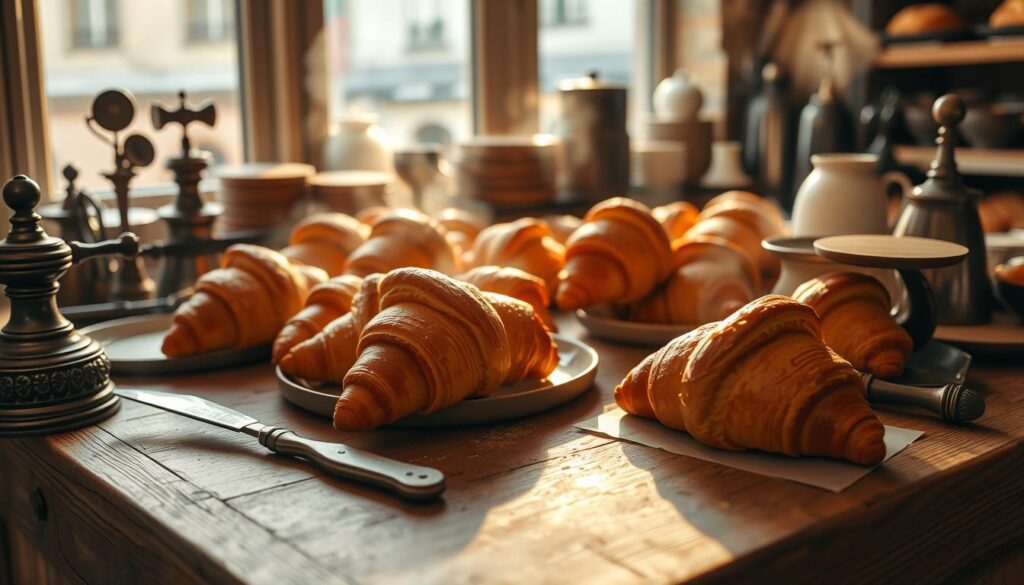Many people get confused between croissants and Swiss Gipfeli. They think these pastries are the same, but they’re not. Each has its own special taste and history. Let’s dive into what makes them different.
By learning about their origins, ingredients, and cultural importance, you’ll appreciate these treats more. You’ll also enjoy making them even more. So, let’s explore the world of croissants and gipfeli together!

Key Takeaways
- Swiss Gipfeli features a distinct crescent shape and a lighter sweetness compared to buttery croissants.
- While croissants boast a rich and flaky texture, gipfeli are more compact yet equally delightful.
- The origins of croissants trace back to the Austrian kipferl, evolving into French delicacies in the 19th century.
- Gipfeli has deep-seated roots in Swiss culinary traditions, symbolizing local baking craftsmanship.
- Understanding the ingredients and baking techniques reveals key differences in achieving the perfect pastry.
Introduction to Croissants and Gipfeli
Exploring introduction to croissants and what is gipfeli offers a glimpse into two favorite pastries. Croissants, a French classic, have roots in the Austrian kipferl from the 13th century. They evolved in the 19th century, becoming a French favorite. Gipfeli, on the other hand, is a Swiss treasure known for its unique taste and texture.
Though both pastries are shaped like crescents, they offer different experiences. Croissants have a light, flaky crust thanks to a special puff pastry method. Gipfeli, by contrast, is denser and has a richer, more savory taste. This pastry comparison shows how each has its own way of being made and its cultural importance.
To fully enjoy these pastries, it’s important to understand their histories and making processes. Croissants have undergone many changes to become what they are today. Gipfeli remains a key part of Swiss traditions, enjoyed at breakfast and celebrations. Learning about these differences opens up a world of pastry delights that many love.

The Origins of Croissants
The history of croissants is a tale of transformation from the Austrian kipferl to the beloved French pastry. It’s believed to have started as early as the 13th century. The Austrian kipferl embodies these origins.
In 1683, after Austria defeated the Ottoman Empire, the kipferl became a celebrated pastry in Vienna. This marked a key moment in the cultural exchange between Austria and France.
Austrian Ancestry and French Fame
The journey from kipferl to croissant shows how food evolves over time. The Austrian kipferl, known for its buttery taste, paved the way for the croissant. When it arrived in France, it sparked a culinary revolution.
In France, the croissant became a staple for breakfast, adapting to local tastes. Today, the global croissant market is valued at 6663.1 million USD. It’s expected to reach 8574.66 million USD by 2027.
Evolution of the Croissant in France
The croissant we know today emerged in the early 20th century. It evolved from the kipferl’s brioche dough to a yeast-leavened laminated dough. August Zang was key in this transformation, introducing puff pastry techniques in France.
This innovation showcased French baking artistry. The croissant became a symbol of continental breakfasts across Europe. Variants like gipfeli in Switzerland and medialunas in Argentina show the croissant’s adaptability in different cultures.

| Pastry | Origin | Key Characteristics |
|---|---|---|
| Austrian Kipferl | Austrian roots, dating back to 1683 | Crescent-shaped, buttery, less flaky |
| French Croissant | Modernized in France, early 20th century | Flaky, layered, yeast-leavened dough |
| Gipfeli | German-speaking Switzerland | Similar to croissant, often less flaky |
| Medialunas | Argentina and Uruguay | Sweeter, softer, often glazed |
| Cornetto/Brioche | Italy | Soft, not as flaky, sweet variants |
| Rogale Świętomarcińskie | Poland | Sweet, filled with poppy seed paste |
The Flour and Ingredients Used
The choice of flour and ingredients is key to the quality and taste of croissants and gipfeli. Knowing the differences in wheat types helps us understand their unique textures and flavors.
Differences in Wheat Types
When it comes to flour for croissants, Swiss wheat and French wheat stand out. Swiss wheat has a higher protein content, around 12-14%. This makes the dough firmer, leading to a denser yet layered texture in gipfeli.
On the other hand, French wheat has a softer texture, with about 9-11% protein. This results in a lighter, more delicate croissant. Using both flours creates different pastry experiences. Swiss wheat makes gipfeli chewier, while French wheat makes croissants flaky and airy.
Butter Content Comparison
Butter is another key ingredient that sets these pastries apart. Croissants use richer butter compared to gipfeli. They often require high-quality European butter, which can be up to $16. This adds a luxurious richness and flaky texture.
Gipfeli, on the other hand, uses about 250g of unsalted butter. This results in a tender dough but less of the indulgent flakiness found in croissants. The careful layering of butter in both pastries creates unique flavors. Croissants are known for their buttery richness, while gipfeli has a subtly sweet, milder taste.
What is the difference between croissants and gipfeli?
The texture and flavor of pastries greatly affect our enjoyment of them. Croissants and gipfeli show different textures and flavors, each with its own charm.
Texture and Flakiness
Croissants are known for their flaky texture. This comes from a special process where butter is folded into dough many times. This makes them airy and fluffy, with a crispy outside.
Gipfeli, on the other hand, is denser but also flaky. It has a unique feel in the mouth that many enjoy.
Flavor Profiles
Croissants are famous for their buttery taste. They use high-quality butter, making them taste rich. Gipfeli, by contrast, is milder and less sweet, appealing to those who like a lighter flavor.
Both pastries come in many flavors. Croissants can be filled with chocolate or other sweet treats. Gipfeli can be enjoyed plain or with a light filling.
| Aspect | Croissants | Gipfeli |
|---|---|---|
| Texture | Flaky and airy due to lamination | Denser, but also flaky |
| Flavor | Buttery richness | Subtle and less sweet |
| Common Varieties | Croissant au Beurre, Pain au Chocolat, etc. | Plain, slightly sweetened versions |
The Process of Making Each Pastry
Croissants and gipfeli differ not just in taste and texture but also in how they’re made. Making croissants is an art that requires patience and precision. It involves complex steps and techniques. On the other hand, gipfeli has a simpler dough that’s quicker to prepare.
Puff Pastry Techniques for Croissants
Making croissants is a detailed process. The dough goes through multiple folds, called lamination, to get its flaky texture. The ingredients include:
- Flour
- Butter
- Salt
- Yeast
- Milk
- Sugar
This mix gives croissants a richer taste and softness. Making them can take two to three days. They are a favorite breakfast item, with about 11.6 grams of saturated fat.
Simpler Dough for Gipfeli
Gipfeli, on the other hand, has a simpler and quicker dough. It uses more butter and milk than croissants. This makes a sweet, crescent-shaped pastry with a simpler flavor. Gipfeli can be ready in half a day to a day, perfect for those who want fresh pastries quickly.
Learning about these techniques helps us appreciate the art of baking both pastries. It shows how different methods create unique flavors and textures in croissants and gipfeli.
Regional Variations in Each Pastry
The world of pastries is full of choices, like the types of gipfeli and French croissant varieties. Each place adds its own special touch. This makes exploring unique gipfeli and French pastry types a delightful journey for those with refined tastes.
Diverse Types of Gipfeli
Switzerland is known for its wide range of Swiss pastry varieties, including gipfeli. These vary a lot across different cantons. Some notable types are:
- Schoggigipfeli: A chocolate-filled delight that’s perfect for those with a sweet tooth.
- Laugigipfeli: Known for its savory lye-covered crust, it offers a unique texture.
- Vollkorngipfeli: A whole-grain pastry that’s loved for its nutty taste and healthy ingredients.
- Nussgipfel: Filled with chopped hazelnuts, it combines butteriness with a strong nutty flavor.
- Mandelgipfel: An almond-flavored treat that is sweet but subtle.
These variations show how regional preferences differ, influenced by local ingredients and traditions.
French Croissant Varieties
In France, the croissant has many adaptations, each with its own flavors and fillings. These reflect local tastes. Some common French pastry types are:
- Traditional Butter Croissant: Famous for its flaky layers and rich taste.
- Almond Croissant: Filled with almond cream and topped with sliced almonds for a special touch.
- Chocolate Croissant: A favorite with its rich chocolate filling, ideal for those who love sweets.
- Croissant aux Fruits: These mix seasonal fruits with the buttery pastry, adding freshness.
Each croissant type has its own unique qualities, shaped by local baking methods and tastes.
Best Ways to Enjoy Croissants and Gipfeli
Exploring the flavors of croissants and gipfeli is a special treat. They pair well with various accompaniments, making each bite unique. For gipfeli, try butter and jam for a rich taste. Croissants are great with chocolate spread or fruit preserves.
Adding fresh fruits or whipped cream to croissants can make them even better. This way, you can enjoy their full flavor.
Traditional Pairings and Serving Suggestions
Knowing the best pairings can make croissants and gipfeli even more enjoyable. Here are some favorite options:
| Pastry | Serving Suggestion | Beverage Pairing |
|---|---|---|
| Croissants | Chocolate spread, fresh berries | Coffee, espresso |
| Gipfeli | Butter and jam, cheese blend | Herbal tea, hot chocolate |
Popular Breakfast Choices
Croissants and gipfeli are perfect for breakfast. They’re loved in cafés and homes worldwide. Enjoying croissants in the morning is a classic tradition.
Gipfeli, on the other hand, is a favorite in Swiss culture. Their unique textures and flavors go well with morning drinks. These pastries add something special to breakfast, making mornings unforgettable.
Cultural Significance of Each Pastry
Croissants and gipfeli have deep roots in French and Swiss cultures. They are key parts of their culinary scenes, carrying local traditions.
Croissants in French Culture
Croissants are a big deal in France. They are seen as a national treasure, showing off French baking skills. People love them for breakfast or as a snack.
Their buttery taste, with 25-30% butter, makes them special. French pastries are more than food; they show French identity. The croissant’s shape reminds us of its history from the 17th century.
Today, croissants are found in cafés and bakeries. They are symbols of French food, loved worldwide for their taste and texture.
Gipfeli in Swiss Tradition
In Switzerland, gipfeli are a big part of local life. They are sweet, with 18-22% butter, and loved by all. Their unique shape shows Swiss bakers’ creativity.
Gipfeli are a big part of Swiss meals, often with coffee or tea. They show Swiss values of quality and simplicity. In Swiss culture, pastries bring people together, with gipfeli showing Swiss hospitality.
How to Make Your Own Croissants or Gipfeli
Starting to make your own baked goods is rewarding. This section offers a detailed croissant recipe and a simple gipfeli recipe. These are great for both beginners and experienced bakers. Let’s explore these tasty pastries, starting with homemade croissants.
Step-by-Step Croissant Recipe
Making homemade croissants needs patience and careful technique. Follow this guide for successful baking croissants:
- In a bowl, mix 4 cups of all-purpose flour, 1 tablespoon of sugar, 2 teaspoons of salt, and 1 tablespoon of instant yeast.
- Add 1½ cups of cold milk and 1 cup of unsalted butter, cut into pieces. Mix until combined.
- Knead the dough on a floured surface for about 5 minutes until smooth. Wrap the dough and refrigerate for 2 hours.
- Roll out the dough into a rectangle, fold it into thirds, and refrigerate for 30 minutes. Repeat this process three times.
- Roll the dough into a larger rectangle and cut it into triangles.
- Starting from the wide end, roll each triangle towards the tip to form the croissant shape.
- Place the croissants on a baking sheet, cover, and let rise for 1 hour.
- Preheat the oven to 425°F (220°C) and bake for 15-20 minutes until golden brown.
Follow these steps to make light and flaky croissants. They will impress your family and friends. Enjoy them with coffee or jam.
Simple Gipfeli Recipe to Try
Want to try making gipfeli? This easy recipe is perfect for a Swiss pastry:
- Combine 4 cups of all-purpose flour, 1 teaspoon of salt, 2 tablespoons of sugar, 1 tablespoon of instant yeast, 1½ cups of cold water, and ½ cup of unsalted butter in a bowl.
- Knead until the dough is smooth and elastic, about 8 minutes. Let it rise in a warm place for 1 hour.
- Once risen, punch down the dough and divide it into smaller portions. Roll each portion into a circle, about ¼ inch thick.
- Cut the dough into triangles and roll each triangle from the wide end to the tip.
- Place the gipfeli on a baking sheet, brushing with an egg wash, and let them rise for an additional 30 minutes.
- Preheat the oven to 400°F (200°C) and bake for 15-20 minutes until golden and slightly puffed.
These homemade Swiss pastries are a great breakfast option. They follow Swiss culinary tradition. You can add fillings like chocolate or cheese for a personal touch.
Conclusion
Croissants and gipfeli are beloved pastries with unique cultural significance. The croissant’s history goes back to the Austrian kipferl of the 13th century. It has a special lamination process that makes it flaky.
Gipfeli, on the other hand, is simpler to make. It has a straightforward dough that brings out great flavor and appeal.
Both pastries have their own taste and texture. Croissants have changed a lot, with varieties like croissant au beurre and croissant ordinaire. Gipfeli, rooted in Swiss tradition, is loved in many regional forms.
Exploring croissants and gipfeli shows their culinary artistry. They are timeless favorites, loved for their unique qualities. Enjoying a warm croissant or a tasty gipfeli reminds us of the joy of baked goods.
FAQ
What is the main difference between croissants and gipfeli?
Croissants and gipfeli both have a crescent shape. But, they differ in texture, taste, and how they’re made. Croissants are flaky and rich because of more butter. Gipfeli are denser with a softer flavor.
What are the key ingredients in croissants and gipfeli?
Croissants use soft French wheat and lots of butter for their flaky texture. Gipfeli, on the other hand, use Swiss wheat and less butter. This makes them denser but fluffy.
How are the preparation methods for croissants and gipfeli different?
Making croissants is complex, involving layers of dough and butter for a light texture. Gipfeli, by contrast, have a simpler dough. This makes them quicker to bake at home.
Are there different types of croissants and gipfeli?
Yes, there are many types. Croissants include Almond, Chocolate, and Butter. Gipfeli come in flavors like chocolate, lye-covered, and whole grain.
How can I enjoy croissants and gipfeli?
Croissants are great with chocolate spread. Gipfeli are best with butter and jam. Both are perfect for breakfast, often with coffee or tea.
What is the cultural significance of croissants and gipfeli?
Croissants are a big deal in French culture, showing off culinary skill. Gipfeli are a Swiss tradition, enjoyed at home and in social settings. They reflect local tastes and traditions.
Can you provide a simple recipe for making gipfeli at home?
Sure! Making gipfeli at home is easy. You’ll need yeast, high-protein flour, and butter. Shape into crescents and bake until golden. It’s a great recipe for beginners.
What is the butter content difference between croissants and gipfeli?
Croissants have more butter, about 25-30%. This makes them rich and flaky. Gipfeli use less butter, around 10-15%. This gives them a milder taste.
